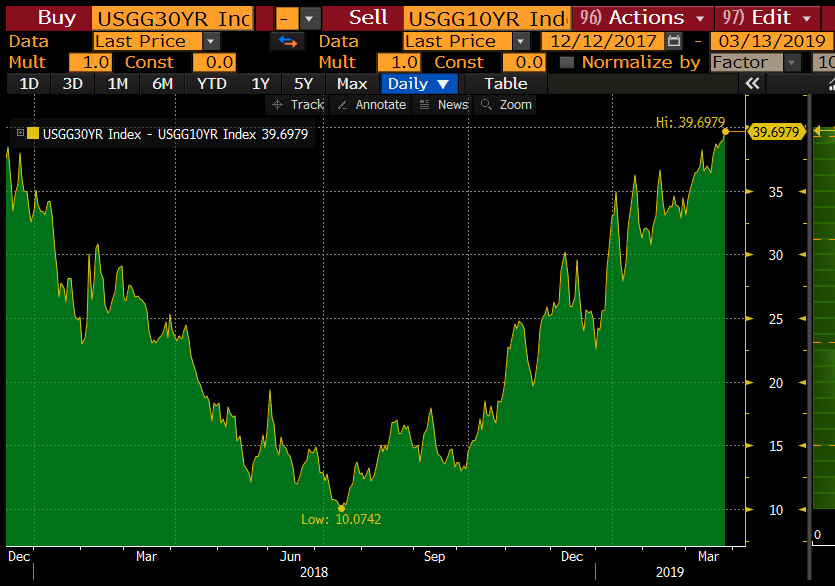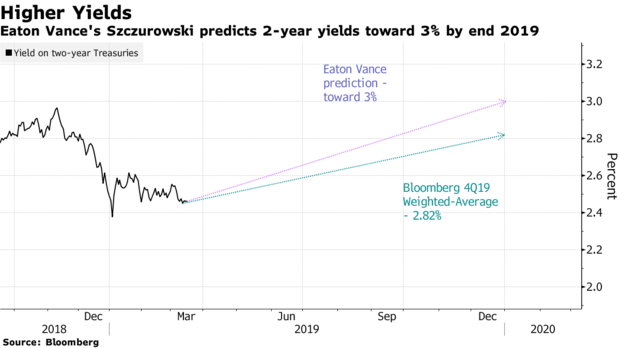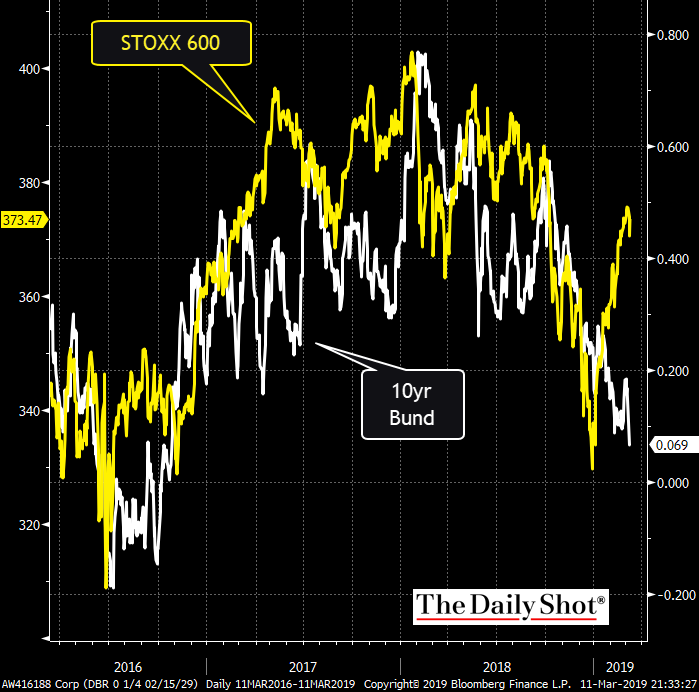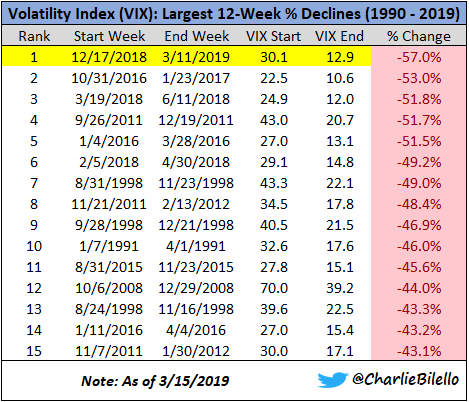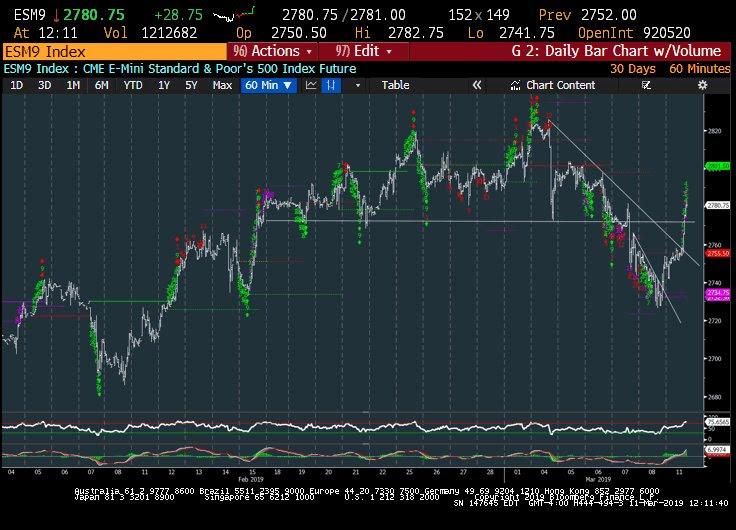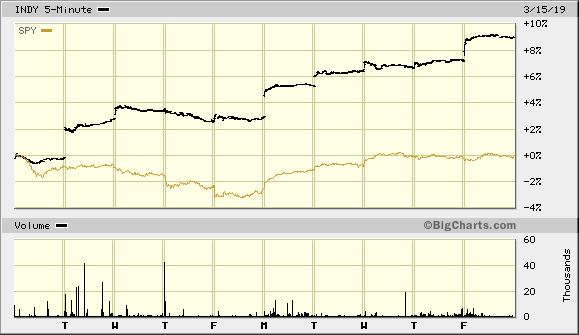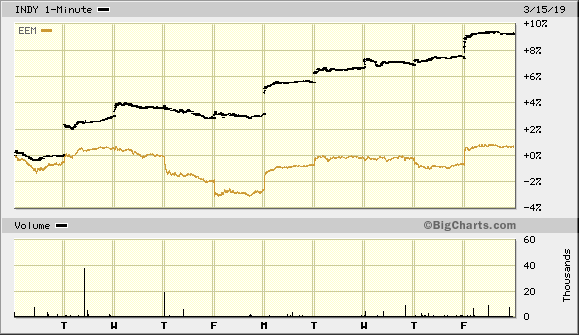Summary – A top-down review of interesting calls and comments made last week in Treasuries, monetary policy, economics, stocks, bonds & commodities. TAC is our acronym for Tweets, Articles, & Clips – our basic inputs for this article.
Editor’s Note: In this series of articles, we include important or interesting Tweets, Articles, Video Clips with our comments. This is an article that expresses our personal opinions about comments made on Television, Tweeter, and in Print. It is NOT intended to provide any investment advice of any type whatsoever. No one should base any investing decisions or conclusions based on anything written in or inferred from this article. Macro Viewpoints & its affiliates expressly disclaim all liability in respect to actions taken based on any or all of the information in this article. Investing is a serious matter and all investment decisions should only be taken after a detailed discussion with your investment advisor and should be subject to your objectives, suitability requirements and risk tolerance.
1.Powell on Deck
What is the state of inflation since it is supposed to be relevant to the Fed?
- David Rosenberg@EconguyRosie– Today’s CPI data confirmed that the peak in core inflation has been turned in. The YoY trend peaked either just ahead of the last three recessions or just as it was getting started. The NFIB index confirmed that pricing power is fading and fading fast.
What about those who say “no recession”?
- David Rosenberg@EconguyRosie – Goldman Sachs CEO says no recession. Meanwhile, we have seen peaks in aggregate hours worked (Jan.), real sales (Nov.), real weekly wages (Jan.) and IP (Dec.). The market surely was pricing something in during the Q4 meltdown! It may have arrived.
Since the European economy is in a worse condition, it may be worth asking what’s next for Europe?
- LongConvexity@LONGCONVEXITY – MS on Europe “we expect the largest fiscal boost in a decade this year. While not very big in size, and not a given that it will continue next year too, we think that this will contribute to provide some needed economic stimulus.”
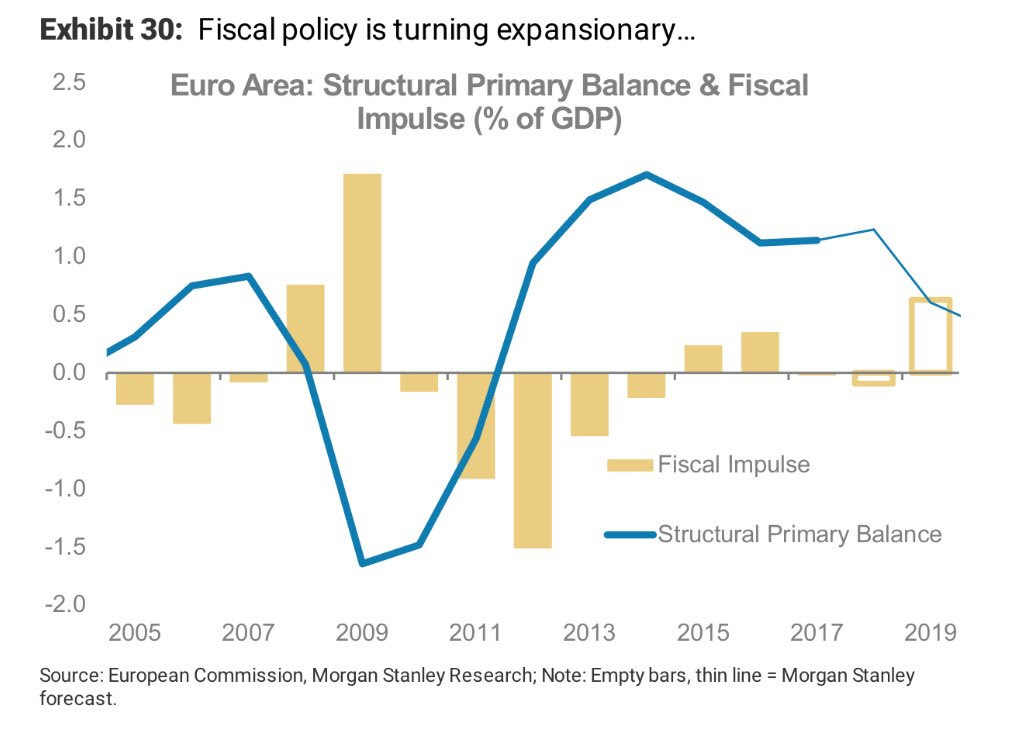 Hmm; is the Fed likely to follow? A reliable indicator is supposed to be steepening in the spread between the 30-year yield & lower maturity yields.
Hmm; is the Fed likely to follow? A reliable indicator is supposed to be steepening in the spread between the 30-year yield & lower maturity yields.
- Bear Traps Report @BearTrapsReport – 13 Month Highs in 5 30s! Markets pricing in dovish expectations here Fed meets next week.
Not merely the belly of the curve but even the 10-year.
- Lisa AbramowiczVerified account@lisaabramowicz1 – Demand for 30-year Treasuries was a bit muted at today’s auction, which is interesting in light of the strong 10-year auction yesterday. The 10-30 year U.S. yield curve has steepened to the the widest since late 2017.
And this is not happening in a bear market for rates. The 10-year yield broke below 2.60% on a weekly close on Friday. This takes it closer to the 2.55% level of Rick Santelli. If this level is broken, the 10-year yield would make a closing lower low for 2019.
On the other hand, if the 10-year bounces hard from close to the 2.55% level, then it could form a double bottom.
Into this significant inflection point steps in Fed Chairman Powell on Wednesday.
2. Rates
The 30-year yield was the only one that closed higher on the week, by a mere 1/2 bps. In contrast, the 10-3 year yields fell by 3-4 bps. And the entire 1-7 year curve inverted with 1-year higher than the 7-year yield by 4 bps and higher than the 5-year yield by 12 bps.
The only one who can fix this inversion is Fed Chairman Powell. The big question is whether he signals a modicum of hawkishness either in the FOMC statement or in his presser.
Some, like Eaton Vance Management’s Andrew Szczurowski, predict that “the Fed could instead lift interest rates once or even twice this year and then “three more for the cycle itself,”” adding that “it’s not unreasonable” for two-year Treasury yields to climb back toward 3 percent by the end of this year.
But will Chairman Powell signal any possibility of a later rate hike next week? What could happen if he does, especially when no one expects it? After all, this past week showed the 2nd largest inflow ever into stocks & bonds. Remember the capitulation in stocks & bonds that forced Chairman Powell to change course in January? Is another capitulation developing now?
- Andrew Thrasher, CMT @AndrewThrasher – “They’re ‘coming for it’, with last night’s EPFR $ flows data showing that the remarkable prior redemption trend outOF risk assets – despite the massive YTD rally – has now forced a developing capitulation back into both risk-assets AND US Treasuries” – Charlie McElligott
Not just in US but also in Europe:
- (((The Daily Shot))) @SoberLook – Chart (@TheTerminal): Europe’s stock market has diverged from Bund yields –
Draghi & his ECB are not getting hawkish any time soon. So what happens to the US Dollar if Chairman Powell surprises the markets with a greater hawkish stance than expected?
- Driehaus @DriehausCapital – Stars are aligning for dollar weakness. Objectively supportive dynamic for emerging markets. AA #DrieahausEM
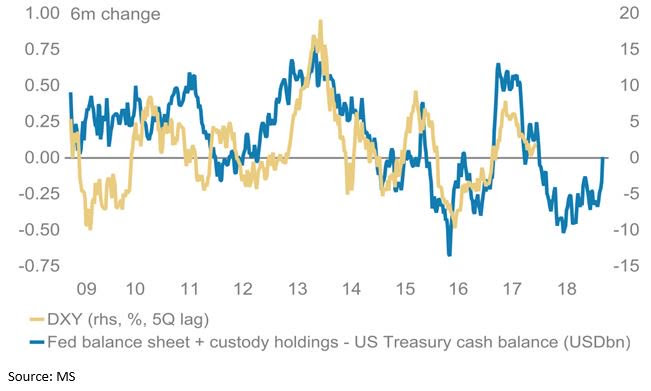 We see that all the markets are signaling that the Fed has become “patient” or withdrawn to the sidelines. Will Chairman Powell tell us they are right or will he dare to surprise them even a little even to gently suggest a rethink at the June meeting?
We see that all the markets are signaling that the Fed has become “patient” or withdrawn to the sidelines. Will Chairman Powell tell us they are right or will he dare to surprise them even a little even to gently suggest a rethink at the June meeting?
Is there any indicator that is even raising its head to suggest a hiccup courtesy of the Fed?
3.VIX
Then you have the history of $VIX:
- Charlie BilelloVerified account @charliebilello – The Volatility Index has fallen 57% over the past 12 weeks, the largest 12-week decline in history. $VIX
How would a trader express this?
- Bob Lang @aztecs99 – GOOD DAY TO TAKE MORE STUFF DOWN, RAISE SOME CASH, AND HAVE SOME PUT PROTECTION.
4. Stocks
Having discussed what Chairman Powell might or might not signal, let us look at non-Fed opinions.
- Mark Newton @MarkNewtonCMT – – Today’s ability to recapture last weeks early lows @ S&P 2772 and 7073 in $NDX is an encouraging near-term development technically & on a close, bodes well for further near-term gains into early April– Visit http://newtonadvisor.com to see Daily/weekly reports & long/short picks
Another view:
- Urban Carmel @ukarlewitz – Cleared the Oct-Dec range + the 2018 downtrend. Now back in the range that prevailed in mid-2018. All clear? No, but things are looking constructive/less crappy in Europe, the most problematic region
 That brings us to the man who was so right last fall. Mike Wilson of Morgan Stanley said he would buy any real decline (not the 2% step back of the week before) he sees.
That brings us to the man who was so right last fall. Mike Wilson of Morgan Stanley said he would buy any real decline (not the 2% step back of the week before) he sees.
That brings us to new highs, perhaps?
- Ryan Detrick, CMT @RyanDetrick – Is now like 2016? Remember, the NYSE A/D line broke out months before the S&P 500 eventually followed suit to new highs. This is how it works, breadth tends to lead price. Could the breakout in breadth mean eventual new highs for the S&P 500 in 2019?
For the 2nd week in a row, the Indian Stock market rallied furiously with EPI, INDY up almost 6% on the week, doubling the performance of EEM & S&P for the week. Remember the air attack on Napak terrorist camp was on Feb 26-27. Look at the rally during the two weeks after the attack both in absolute & relative terms:
For a more detailed discussion see our adjacent article – Propulsion From Balakot To A Second Term For PM Modi? That brings us to President Trump.
5. Trump Administration & India
Almost everybody realizes that PM Modi broke out of India’s self-confined posture against Napakistan with the Balakot strike. But very very few realize how the Trump Administration broke out of America’s self-confined posture about giving in to Napaki game of nuclear chicken. A big part of that is President Trump & his carefully constructed image. As Ashley Tellis of Carnegie wrote this week:
- “Trump is uniquely positioned in this regard. He already harbors an intense dislike of Pakistan’s perfidy, and he has the required recklessness to make any game of chicken that Pakistan chooses to play a losing proposition for Rawalpindi.”
And, in contrast to other situations,
- “Unlike previous U.S. attempts at crisis management, which involved visible trips to the region by high-profile dignitaries, the Trump team settled for intense behind-the-scenes pressure on Pakistan mounted by the highest levels of the U.S. government and conveyed through clear messages delivered by the secretary of state, the national security adviser, and senior U.S. military officials to their Pakistani counterparts. This preference for recessed diplomacy was grounded in the judgment that it would allow Pakistan to save face while still complying with U.S. terms.”
Now you understand why Mr. Gurumurthy publicly thanked President Trump in his tweet for the release of Indian Wing Commander Abhinandan.
But where is the break from the previous US policy?
- “Rather, giving vent to Washington’s exhaustion with Pakistan’s decades-old duplicity on terrorism, Bolton … consciously sought to undermine the traditional Pakistani strategy of nuclear coercion by signaling that the United States would neither intervene to shield Pakistan from Indian retaliation nor offer Rawalpindi any form of exculpatory support. Secretary of State Mike Pompeo confirmed this approach publicly when he declared on Twitter, seemingly the administration’s preferred channel for strategic communications, “We stand with #India as it confronts terrorism. Pakistan must not provide safe haven for terrorists to threaten international security.””
Kudos to the Trump Administration. They are such a refreshing change from the old elite of foreign policy. But one big question remains. Whether the Trump Administration decides finally to strike Taleban sanctuaries located in Napak-occupied territory and put debilitating pressure on the Napaki military.
Without a clear & present danger to their sanctuaries, the Taleban have no reason to deal with America as they are winning on the ground. And without an existential danger to the Napaki military leadership & their families, Napak will not cease to aid the Taleban. And an unsuccessful exit from Afghanistan will end up haunting President Trump even more than the hasty exit from Iraq haunted President Obama.
6. You call that a “scam”?
We have been looking at the recently disclosed college education “scam” from two separate angles. First & foremost, we have known how screwed up the process is. Any one who knows something about private schools in Manhattan knows about admissions to elite schools – you almost require parents or more commonly grand parents who donated huge sums to Ivy League schools when a couple of million was deemed huge. And if you are an Asian minority, you know you have to stand out among other Asian students. You should know what schools really want – like know that Harvard really wants athletes & not 800-score students.
Every one knows the huge amounts Manhattan parents spend to improve SAT scores of their children without much success. In that sense, the “scam” was more sensible. Instead of spending money on middle men, they spent money on the actual decision makers, like say
- Aaron BlakeVerified account @AaronBlake – The head soccer coach at Yale allegedly accepted $400k for accepting a recruit who didn’t even play soccer. Wow.
All this sounds awful from the traditional American viewpoint. But the reality is that traditional viewpoint went away during the elitism of the Obama Administration. President Obama was an elite & elite-created product. He reveled in it & elitism grew exponentially in his 8 years.
And the absolute foundation of elitism is credentialism. That is behind this scam. Regardless of your Hollywood or other celebrity (say Pimco) status, you must have the right name (credentials) behind your child. The actual education is irrelevant. What is critical to say is that your child went to Harvard or Princeton.
Indian American parents know how extreme such credentialism can get. For example, in some Indian-American circles in Manhattan, Columbia University is just not “Ivy League” any more at least not elite “Ivy”. Your child must go to Harvard, MIT or Princeton (Yale is border-line, Stanford counts but is too far) for parents to feel proud. If Columbia is infra-dig, what about Brown, Cornell et al? Not quite untouchable but kinda close!
And understand Indian-Americans are really not at the forefront of such Indian elitism. That is reserved for children of wealthy Indian parents from India. For example we have heard that, even at non-elite NYU, such wealthy Indian children from India do not associate with Indian American students. These “elite” Indian kids from India stay in expensive townhouses & bring/employ cook/maids to serve them while they “study” in US schools. So do you really think, these kids or their parents worry about tuition fees or any other payments for them to get in?
And yes, all US schools put Indian-American applicants & Indian kids from India in the same admission bucket. This has curtailed acceptance rates for Indian American children at MIT, Princeton & other elite schools. This is not theoretical but based on actual cases.
So the “scam” itself is not that novel but there is a novelty to it, speaking from an Indian Indian point of view. What is so gratifying is that the US & State attorneys were diligent in investigating this scam & indicting the parents & school officials. That makes us thrilled about the standard of morality & fair play in America & makes some Indians from India marvel & laugh simultaneously. Because in India, the Government attorneys would investigate such a scam but NOT to indict but to extract greater sums of money from parents & school officials.
We are not kidding. As we have been told, if you go to the Indian Police to file a case, the immediate calculation the police inspector makes is whether he is likely to get more money from you or the guy against whom you are filing the case. Lawyers are worse, we are told. Because your lawyer, after getting all the fees they can from you, often contacts the opposite party and asks how much they will pay your lawyer to weaken/throw your case. Is this all possible without even greater corruption in the judiciary? You decide for yourselves.
The point being we are thrilled to see US & State attorneys take action against the last & most corrupt bastion of elitism in America – the name brand Universities. They have been very smart in collecting champions in every field. Just look at how many Fin TV anchors in New York serve the interests of their schools rather than care about what their schools are doing to students & America itself.
Send your feedback to editor@macroviewpoints.com Or @MacroViewpoints on Twitter

